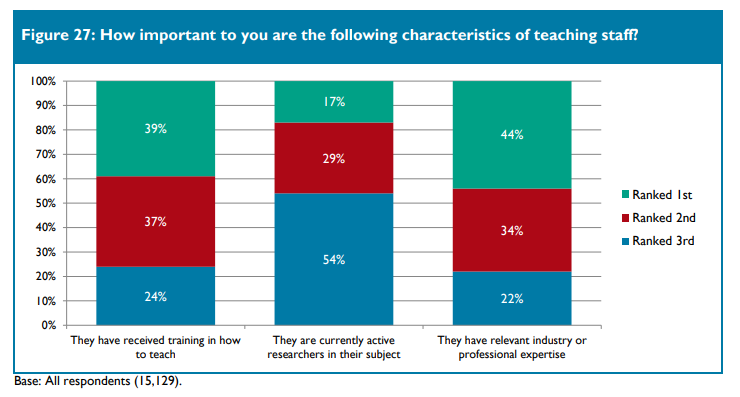Over the last two decades, as student fees have increased, so too have concerns that students do not receive ‘value for money’ from their education. The Conservatives set out to change this in 2015, through the Teaching Excellence Framework (TEF). Drawing on the HEPI/HEA Student Academic Experience Survey, they identified student priorities such as “having more hours of teaching”, “reducing the size of teaching groups” and “better training for lecturers”.
What do students value?
Yet the TEF has focused on the academic side of teaching, and ignored perhaps the most interesting finding of the 2015 Student Academic Experience Survey; 44% of students rated industry experience as the most important characteristic of their teaching staff.
That’s more students than rated training in how to teach as most important (39%) and significantly more than prioritised staff being active researchers in their field (17%). Of course, this result varies by type of institution and subject. Nonetheless, it is an important finding, and one which has received little attention.
As the Teaching Excellence Framework develops it will be important to keep in mind this finding.
Dual-Professionals in GuildHE institutions
At GuildHE, many of our institutions are closely aligned to professions and provide highly vocational education. Whether in creative arts or agri-tech, sports science or cyber-security, or a whole host of other subjects, many teachers continue to work in their industry, as “dual-professionals” or “practitioner-teachers”. The HEPI/HEA survey demonstrates that these staff members have real credibility amongst students.
GuildHE are currently working on a project, which will explore some of the benefits and challenges of working with these practitioner-teachers. Yet it seems clear from the outset that many students will benefit from a more employment-focused experience of higher education.
Practitioner-teachers are able to integrate real-world experience into their teaching, providing first-hand knowledge of how to address specific professional challenges. They will help students understand how the skills accrued through years of study are relevant when applying for graduate jobs. Practitioner-led teaching and placements can also provide students with access to informal networks, which may provide routes into industry or professional roles. This opens up new possibilities, especially for students with low social capital.
Having staff working in both industry and teaching is not without its challenges though. This can include supporting staff to recognise that just because they are experts in their field they may not automatically be expert teachers. There are also a range of more practical issues including the wide range of contracts that these staff are likely to be on.
Practitioner-teachers and the TEF
As we approach the Independent Review of the TEF, and consider possible models for a subject-level TEF, we should develop methods to reflect the value that dual-professionals bring to the teaching of a wide range of subjects. This should sit alongside other important factors such as “having more hours of teaching”, “reducing the size of teaching groups” and “better training for lecturers” A nuanced approach that truly recognises and rewards excellent teaching, will value practitioner-teachers alongside more traditional academic roles. We hope that, by showcasing the benefits of practitioner-led teaching, our project will help expand the picture of what excellent teaching looks like.
To find out more about GuildHE’s work on practitioner-led teaching, please contact jack.fleming@guildhe.ac.uk


